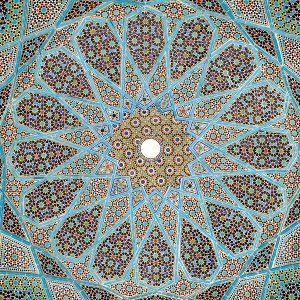One such artefact that survived is the tile. Centuries ago it was the decoration above all decorations that showcased the advancement, skill and pride of an empire from miles away. It was the first impression visitors got of a place before a word was even spoken.
One of the earliest remaining examples of decorative tiles can still be seen in the Chogha Zanbil zuggarat in Iran. It was an Elamite temple and dates back to around 13th century BC. There are many other examples of this in the Ancient world, especially Egypt and Mesopotamia and a recreation of the exquisite Ishtar gate of Mesopotamia was made at the Pergamom Museum in Berlin, to give us an understanding of just how magnificent these empires and their creations were.
In the beginning each tile was glazed with one colour and a pattern or design built with it, but in later centuries the designs on each tile became more complex. It is especially during the Islamic Era in Iran that the decoration of special buildings, especially mosques, took on a whole other life. Mathematics, science and sacred geometry were used in all forms of art since these disciplines were the only accepted proof of the magnificence of the Creator and the result is works of art that still take our breaths away. It was also believed that these exact measurement and shapes lent magical properties to buildings. This was borrowed from older religions of Iran where priests were not just spiritual guides but also highly advanced mathematicians, astronomers, scientists, inventors, healers, teachers, philosophers and alchemists who understood the powers behind Creation. Persian carpets too were created using specific mathematical measurements, scientific methods and sacred geometrical shapes with the same understanding, and its designs became the blueprint for tile designs centuries later.
The girih tile method used (which actually translates to “knot” in Farsi and is a perfect example of Islamic tile art) is piece-wise straight lines which cross the boundaries of the tiles at the center of an edge at 54° (3π/10) to the edge. Two intersecting girih cross each edge of a tile. Most tiles have a unique pattern of girih inside the tile which are continuous and follow the symmetry of the tile. However, the decagon has two possible girih patterns one of which has only fivefold rather than tenfold rotational symmetry. The girih tilings possessed properties consistent with self-similar fractal quas icrystalline tilings. This is quite extraordinary since such properties were only discovered in recent times with the invention of the microscope. The Buddhist mandala holds similar properties.
Through the Islamic expansion into Spain the skill to create glazed tiles was passed on and the Spanish added their own flair and favourite colouring. This influenced tile designs in all of Europe, worth noting is the Portuguese and Dutch Delft tiles. When the Spanish conquered the Americas, they passed this skill on to the Mayans. Mexico is rich in natural resources and the most common was and still is clay. The town of Puebla established in 1531 was home to Mexico best quality clay material. It quickly became a center of pottery and earthenware tile production of colonial Mexico. The most prominent type of Mexican pottery and tile was called Talavera introduced by Spanish monks during the sixtieth century. At the time they were in great need of Spanish earthenware products. As a result they invited to Mexico craftsmen from Talavera de le Reina. The Spanish craftsmen introduced talavera ceramic production techniques to indigenous population of Puebla. It was a beginning of Mexican tiles used throughout the centuries for decorating public buildings, churches and monasteries.
The city of Kashan is still the capital of tile making in Iran. In fact, the word for tile in Farsi is “kashi” referring to its place of origin. Even though Kashan itself dates from the Elamite period around 7,000 years ago, its tile industry only really took shape during the Islamic Art Era and still thrives today. All the exquisite and magnificent buildings in Iran are mostly decorated with tiles produced in this city.
Sources:



